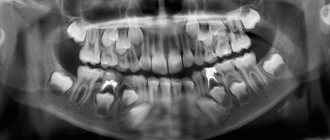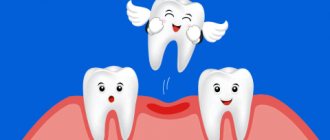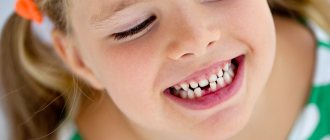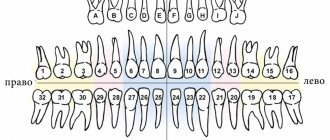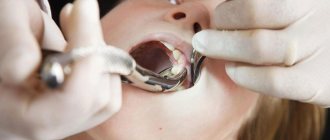A child needs dental services from the first year of his life. As soon as teeth begin to emerge, it is better to immediately show the child to a specialist. A simple inspection would be a great start. Continued regular visits to the dental clinic will help your child maintain healthy teeth for many years to come. He will have a beautiful smile and will not suffer from health problems.
Popular types of x-rays of baby teeth in children
Modern pediatric dentistry allows us to solve any problems with baby teeth. But in order to consider the disease and make a correct diagnosis, it is not enough just the child’s complaints and his description of pain and discomfort. In order for treatment to be as effective as possible, it is necessary to build a treatment plan based on diagnostic data that can be obtained after one of four popular types of radiography:
- Sighting (periapical). Indicated in cases where clarification is necessary on one or more adjacent teeth (from 1 to 3). Provides data about the units themselves, their roots and surrounding soft tissues.
- Occlusal (palatal). As a result, the attending physician receives a complete projection of one of the child’s jaws. The technique is used to determine possible malocclusions and anomalies of the dentition in general.
- Panoramic (orthopantomogram). Allows scanning of the entire oral cavity. An orthopantomogram for children is indicated for a detailed study of pathologies of the upper and lower jaw, the temporomandibular joint and the maxillary sinuses. The results of such an x-ray are necessary for further dental correction. This type of examination is prescribed for children with a fully formed dental system, that is, from about 9 years old.
- 3D pictures. A three-dimensional X-ray image of children's primary teeth allows us to obtain data on all units (existing and not yet erupted). The entire maxillofacial area is subject to examination. The photographs can be used to evaluate the structure of the entire skeletal system of the jaws, the condition of the root system (including pathologies), inflammation in soft tissues, etc. Such dental x-rays are prescribed for the purpose of making a diagnosis and as a control study after canal filling.
Depending on the existing problems with baby teeth, the child may be prescribed one specific or several different types of examination. The attending physician will definitely explain the advisability of obtaining images and the need for x-rays.
You might be interested in:
Dental diagnostics
Pediatric orthopantomogram
3D image of teeth
Differences between pediatric and adult dentistry
Some diseases of the maxillofacial system originate in early childhood. Adults no longer have such problems. Approaches to treating even the most standard diseases vary. The doctor must have a perfect knowledge of the child’s anatomy and be able to distinguish normal from abnormal in all aspects of the development of the dental system. He must accurately prevent any deviations and deal with them before they lead to more significant problems. Here are a few more of the most significant differences.
- Oddly enough, pediatric dentistry is more complex, contrary to popular belief. And you need to choose a doctor with special care; you cannot trust your child to an inexperienced specialist.
- The children's dental system is not so susceptible to infection, and therefore the doctor only in exceptional cases encounters infectious diseases characteristic of adults.
- Each procedure must be performed under anesthesia. A modern doctor has several types of local anesthesia, as well as sedation, in his arsenal. The master’s filigree work is so painless that the child may not feel the injection at all, which means there will be no chance of developing a fear of the dental chair.
- Childhood caries is more dangerous. An almost imperceptible whitish spot on a tooth grows into a large-scale carious cavity in a matter of months. It is important to closely monitor children's oral health and take them to the doctor on time. And the dentist, in turn, is obliged to eliminate even the most minor defects in order to prevent their rapid development.
- A baby tooth is structured differently than a permanent tooth, and therefore the filling is carried out differently.
- When treating a baby tooth, the dentist must take into account the location of the buds of permanent molars.
- Many different materials and instruments are used that may not be available in a standard dental clinic.
A good pediatric dentistry always has first-class specialists on its staff who are capable of treating children.
A dentist for adults may simply have sufficient qualifications, but a pediatrician must be an excellent psychologist. He must understand how to calm the child and confidently apply this knowledge in practice. One of its most important tasks is to prevent fear of the dental chair. Pediatric dentistry prices
| Service | Price |
| Treatment of pulpitis of a baby tooth in two visits | 7500 rub. |
| Restoration of a baby tooth with a standard metal crown | 6000 rub. |
| Treatment of medium and deep caries of primary teeth, with anesthesia | 3800 rub. |
| Professional hygiene of baby teeth | 3000 rub. |
| Complex milk tooth extraction with anesthesia | 2500 rub. |
| Removal of a baby tooth with anesthesia | 2000 rub. |
| Consultation with a pediatric dentist | 1500 rub. |
| Remineralization of baby teeth | 2500 rub. |
When is a child's dental x-ray prescribed?
It is important for parents to understand in what cases it is necessary to take an x-ray of children’s baby teeth. Detailed diagnostics may be required in a variety of cases (depending on the individual characteristics of the structure and development of the dental system). Most often, radiographic examinations are prescribed in the following cases:
- To identify deep caries. Milk teeth, unlike permanent teeth, have more fragile enamel. Consequently, they are more susceptible to exposure to aggressive substances that enter the mouth with food. Carbonated drinks, fast food, sweets - all this causes the appearance of caries, which is not always noticeable upon visual inspection. At routine visits to the dentist, with x-rays, you can verify the absence or confirm the presence of deep caries.
- To study abnormalities in the development of teeth and jaws. If a child has problems with teething, abnormal growth, or pain when closing the jaws, this may be a reason to take an X-ray of the children’s baby teeth. The results will allow us to study the existing problems in detail and intervene in a timely manner, solving issues of delayed growth of units and many others.
- To monitor the condition of permanent teeth. Not only baby teeth, but also permanent children’s teeth require special attention even before they appear. Studying the rudiments allows not only to determine possible anomalies, but also to make predictions about the timing of eruption.
- Bite study. An incorrect bite can cause premature tooth wear and the appearance of various pathologies. An X-ray of a child’s teeth can provide detailed data on the position of the jaws in order to identify even the slightest deviations from the norm.
- Detection of abscesses. Inflammatory processes in the initial stages may be asymptomatic. An advanced abscess can cause serious operations, including surgical ones. At the same time, x-rays can show foci of inflammation and begin treatment on time.
Some children are so mobile and active that they often get injured, including in the jaw. Serious injuries may be visible during visual inspection, and some cracks and misalignments can only be diagnosed after X-raying the child's teeth.
Most adults have memories of going to the dentist as a child. A strict doctor, a cold, uncomfortable chair, a loud drill and pain from drilling into caries - all this introduced stress and developed in many people the habit of avoiding going to the dentist until the pain becomes unbearable. Some adults teach their child this behavior, which is wrong: modern anesthesia completely blocks pain, and the patient does not feel anything during treatment. In addition, baby teeth need care and timely treatment just like permanent teeth. Therefore, avoiding a visit to the doctor is harmful. The Family Clinic offers treatment of primary teeth for preschoolers and adolescents. Doctors at our clinic are able to find the causes of diseases and select the most gentle method for their correction. The clinic has reasonable prices, and pediatric dentist appointments are held in a child-friendly manner.
In what cases should you contact a pediatric dentist?
Caries
. In childhood, tooth enamel is thinner than in adulthood. She is often affected by caries. Not all children brush their teeth with discipline twice a day and immediately tell their parents about the pain due to fear of dentists. Therefore, caries develops quickly and can spread to the permanent teeth that grow under the milk teeth. The sooner the child is in the chair of a good doctor, the greater the chance of keeping the molars healthy.
Gum inflammation
. A child’s gums are vulnerable to bacteria, which is why preschoolers and teenagers often suffer from stomatitis. With a decrease in immunity, gingivitis and even periodontitis develop. At the first symptoms of gum problems, you need to make an appointment with a pediatric dentist. Our medical center offers many services related to the treatment of gums in children and adults.
Why is it important to treat baby teeth?
Diseases of baby teeth are often asymptomatic and make themselves felt at the stage when they already have to be removed. The condition of your teeth and gums directly affects your overall health. Therefore, you need to go to the doctor for an examination and agree to treatment on time for several reasons:
- How healthy or sick the baby teeth are, the permanent teeth will be just as healthy or problematic. In advanced cases, they grow up already damaged, and the child’s parents have to spend a fortune on dental services to correct the situation.
- Carious and crooked milk teeth do not allow you to chew food normally and soak it with saliva. The child swallows pieces of food, resulting in gastritis and intestinal problems. All this will not happen if the parents took the person to the children's dental clinic on time, and the doctors immediately corrected the defects.
- Early removal of baby teeth destroyed by caries is the most common cause of malocclusion, distortion of the shape and relative position of facial bones, and the appearance of speech defects. This leads to the appearance of complexes in adolescence and adolescence.
Answers to frequently asked questions about x-rays of baby teeth in children
We offer expert answers from specialists from the Smile Factor network of clinics to frequently asked questions by parents.
Can an x-ray be prescribed to a child “just in case”?
Unfounded medical (and dental) research is prohibited by SanPiN.
But, most often, diagnosis according to indications is at the discretion of the attending physician. Any parent can ask clarifying questions and learn more about the assigned test and what it is for. What is better - 2D or 3D scanning result?
It all depends on the goals of the diagnosis.
In some cases, a 2D image is sufficient, while in others a CBCT scan is required to obtain a 3D image. Taking into account how CT scans of the jaw and teeth are done, the procedure is not much different from a simple x-ray in terms of safety and is indicated for obtaining more extensive data about the child’s dental system in the images. Are x-rays harmful to a child?
Modern X-ray machines (and most often these are ultra-modern tomographs) produce the minimum possible radiation dose during operation, which does not cause any harm to the child’s body. To achieve the maximum recommended radiation exposure of 1000 µSv per year, a child needs to undergo about 400 x-ray examinations. It becomes clear that so much research is simply not needed. And the radiation that a baby receives during a CT scan is equal to what he receives after a week of watching TV.
Read also
What to do if your tooth aches
Sometimes aching pain in a tooth can appear for no apparent reason at first glance.
Why do teeth crumble?
Tooth decay in general, and crumbling in particular, is not an aesthetic problem.
